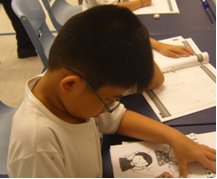What’s the Problem in Problem sums?
 Many parents are concerned with the difficulties faced by their child when trying to solve problem sums and many children are frustrated and stressed out that no matter how many times they read the question, they just cannot seem to figure out what to do.
Many parents are concerned with the difficulties faced by their child when trying to solve problem sums and many children are frustrated and stressed out that no matter how many times they read the question, they just cannot seem to figure out what to do.
In an attempt to improve the child’s ability to solve problem sums, many of us would spend more money to buy assessment books that focus on word problems or we may spend our evenings going through the same old type of question with our child, only to have them face difficulty when the same type of question comes up in the exams.
So, what exactly is the PROBLEM in problem sums?
To understand this academic task better, we need to analyse and break down the steps and the underlying skills needed to excel in this section of the subject of Mathematics.
Firstly, we need to understand that there are specific underlying skills (foundational thinking abilities, not content knowledge) a child needs to have in order to be able to solve a word problem effectively.
Alright, let us use a ‘relatively easy’ question adapted from the Primary 2 level to see what underlying skills are needed to solve the question:
Example:
329 people attended a concert on Friday night. This was 97 more than the number of people who attended the previous night. A total of 754 people attended the concert on Saturday and Sunday. What was the final total attendance for the four nights of concert?
Analysis of Skills needed:
- Visual Discrimination
- To clearly see the numbers given in the correct sequence (329, not as 392)
- Meaning of Words (commonly known as Vocabulary)
- When is ‘previous night’ referring to? (Ans: Thursday night)
- The word ‘total’ was mentioned twice, but are referring to different parts of the question
- Verbal Relations (how the words, ideas are related or linked)
- ’97 more than the number…. the previous night’ (more than which number?)
- Were there 754 people for Saturday and another 754 people for Sunday?
- Selecting & Applying Numerical Processes (which numbers to use first, how to use them – addition? subtraction? Or both?)
- There are three sets of numbers: 329, 97, 754 (which order should they be used? And how are they to be used in relation to each other?)
This question may seem easy enough, but for a child to be able to read, understand and solve it correctly, he/she must possess the right set of thinking skills to be observant in reading details, be able to connect and relate the parts together and decide on the steps needed to arrive at the right answer.
So, before a child can excel and perform at any task, we need to be sure they are given the right set of thinking skills.
JOIN US for a Complimentary Learning Assessment to find out more about your child’s underlying skills for learning.
Article contributed by Thinkersbox
